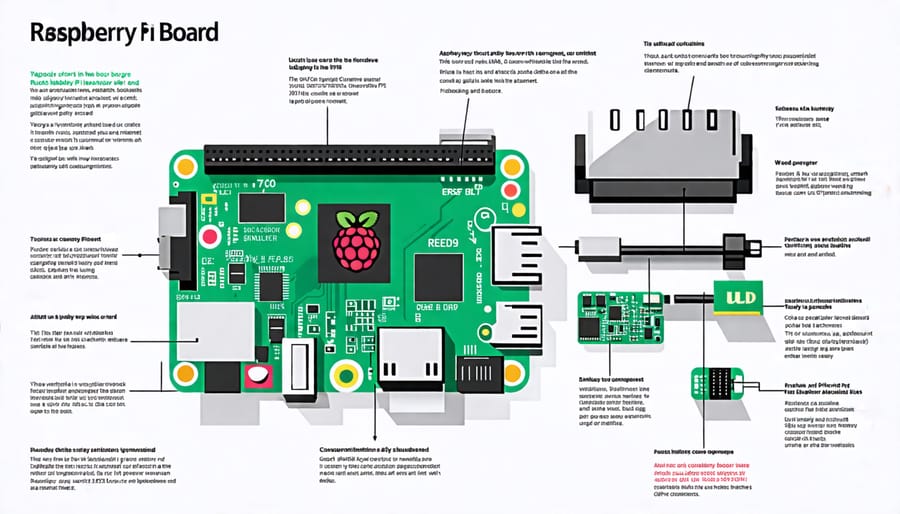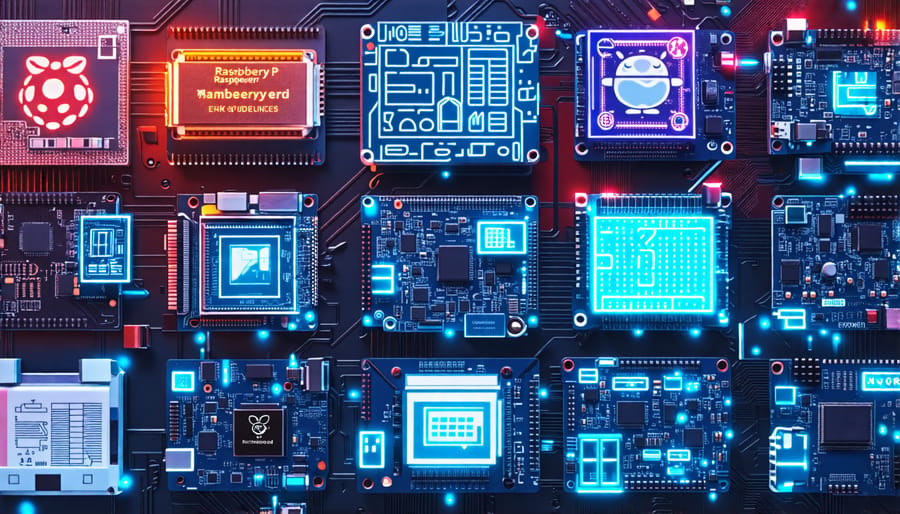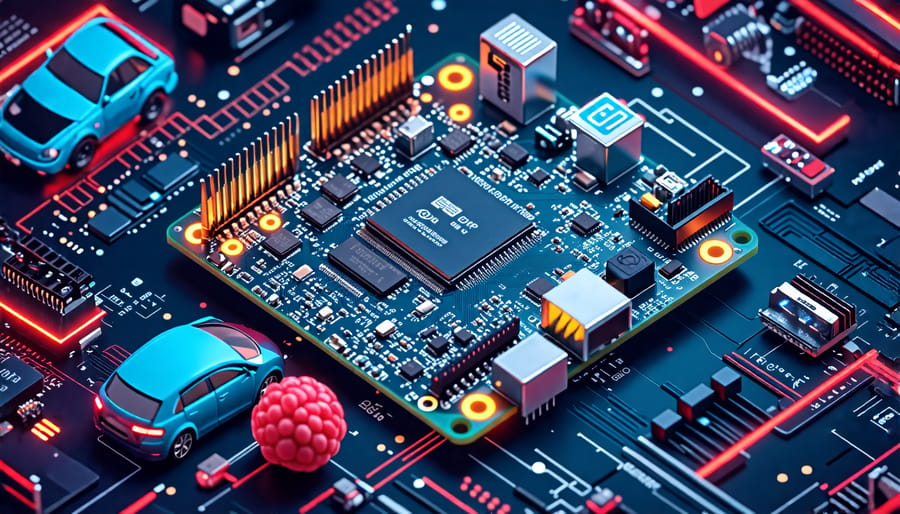Is the Raspberry Pi an Embedded System? A Compact Computer’s Capabilities and Classification The Raspberry Pi has revolutionized the world of computing, offering a credit card-sized device with surprising power and versatility. But where does this innovative single-board computer fit in the broader landscape of computing systems? Specifically, can the Raspberry Pi be considered an embedded system? To answer this question, we must first understand the defining characteristics of embedded systems. These specialized computers are designed to perform specific functions within larger mechanical or electrical systems, often with real-time computing constraints. From the control systems in modern vehicles to the microcontrollers in home appliances, embedded systems are all around us, working tirelessly behind the scenes. So, does the Raspberry Pi qualify as an embedded system? The answer is not a simple yes or no.
What Makes a System ‘Embedded’?
Dedicated Functionality
Embedded systems are engineered to perform specific, predefined tasks within a larger system. Unlike general-purpose computers, embedded systems have dedicated functionality tailored to their intended application. This specialized design allows for optimized performance, reduced power consumption, and improved reliability in the specific context they operate in. Raspberry Pi boards can be configured as embedded systems by loading a customized operating system and software stack focused on a particular task. However, their versatility and expandability also enable them to function as mini-computers for a wider range of applications beyond the scope of traditional embedded systems.
Resource Constraints
Resource constraints are a defining characteristic of embedded systems, and the Raspberry Pi is no exception. Despite its impressive capabilities, the Pi has limited computing resources compared to traditional desktop computers. The Raspberry Pi 4, for example, comes with a quad-core ARM Cortex-A72 processor and a maximum of 8GB RAM, which is sufficient for many embedded applications but may struggle with more demanding tasks. Storage is also limited, with the Pi relying on microSD cards for its operating system and data storage. These constraints require developers to optimize their code and be mindful of resource usage when designing embedded systems using the Raspberry Pi.
Real-Time Operation
Real-time operation is a crucial aspect of embedded systems. Unlike general-purpose computers, embedded devices must respond to inputs and events within strict time constraints. For example, a smart thermostat needs to read temperature data and adjust heating or cooling in real-time to maintain a comfortable environment. While the Raspberry Pi is capable of handling real-time tasks to some extent, it may not be suitable for applications with highly critical real-time requirements due to its general-purpose operating system and hardware limitations.
The Raspberry Pi: An Overview
Hardware Specs
The Raspberry Pi packs impressive hardware specs into its compact form factor. At the heart of most models is a powerful Broadcom system-on-a-chip (SoC), which integrates the CPU, GPU, and RAM. The CPU is typically a quad-core ARM Cortex-A processor, offering ample performance for various applications. Depending on the model, the Pi comes with 1GB to 8GB of LPDDR4 RAM, providing sufficient memory for multitasking and running complex programs. The Pi also features a range of I/O options, including USB ports, HDMI output, Ethernet, and GPIO pins. These interfaces allow users to connect peripherals, displays, and sensors, making the device highly versatile. Models like the Raspberry Pi 1 Model A showcase the Pi’s ability to deliver functionality in a minimalist package. With onboard wireless connectivity, a microSD card slot for storage, and low power consumption, the Raspberry Pi’s hardware is well-suited for embedded applications and projects of all kinds.

Operating System and Software
The Raspberry Pi runs on a Linux-based operating system called Raspbian, which is optimized for the device’s hardware. This OS provides a user-friendly interface and supports a wide range of programming languages, including Python, C++, Java, and more. The Pi’s software capabilities make it an excellent tool for learning programming, developing applications, and experimenting with various projects. Users can easily install and customize software packages, modify system settings, and access a vast library of pre-built tools and libraries. The combination of a powerful yet lightweight OS and the Pi’s programming flexibility allows users to create diverse applications, from simple scripts to complex embedded systems, making it a versatile choice for both beginners and experienced developers alike.
Typical Use Cases
The Raspberry Pi is commonly used in various embedded applications like home automation, where it can control smart devices and sensors. Media center projects are also popular, allowing users to stream content and create personalized entertainment hubs. Other typical use cases include building network attached storage (NAS) devices, retro gaming consoles, and even robotics projects, showcasing the versatility of this compact yet powerful single-board computer.
Raspberry Pi as an Embedded System
Advantages
The Raspberry Pi offers several compelling advantages as an embedded system platform. One of its key benefits is affordability, with models starting at just $35. This low cost makes it accessible to a wide range of users, from hobbyists to professional developers. Despite its budget-friendly price point, the Raspberry Pi packs impressive processing power and connectivity options, enabling it to handle various embedded applications. Another significant advantage is the Raspberry Pi’s flexibility and versatility. Its general-purpose design allows users to customize the device for their specific needs, whether it’s controlling sensors, driving displays, or communicating with other systems. The Pi’s extensive GPIO (General Purpose Input/Output) pins enable seamless integration with external components, making it adaptable to countless embedded scenarios. Moreover, the Raspberry Pi benefits from a thriving global community of enthusiasts and experts who share knowledge, projects, and resources. This strong community support means users can find abundant tutorials, code samples, and troubleshooting advice online. The collaborative nature of the Raspberry Pi ecosystem accelerates learning, problem-solving, and innovation in embedded system development.
Limitations
While the Raspberry Pi offers many benefits as an embedded system, it does have some limitations compared to traditional microcontrollers. The Pi consumes more power than most microcontrollers due to its advanced features and higher clock speeds. This can be a drawback for battery-powered projects or applications requiring long-term, low-power operation. Additionally, the Raspberry Pi’s larger physical size may be a limitation in space-constrained embedded applications. Microcontrollers often come in much smaller packages, making them more suitable for compact devices. However, these limitations can be mitigated through careful design and power management techniques. The Pi’s advantages in performance, connectivity, and flexibility often outweigh its power and size constraints in many embedded use cases. Ultimately, the choice between a Raspberry Pi and a microcontroller depends on the specific requirements and trade-offs of each embedded project.

Real-World Examples
The Raspberry Pi’s versatility has led to its adoption in various real-world embedded applications. In the automotive industry, it has been used to create custom in-vehicle infotainment systems and diagnostic tools. The Pi’s compact size and low power consumption make it ideal for integrating into vehicles. Another fascinating example is the FarmBot, an open-source agricultural robot that uses a Raspberry Pi as its brain. The Pi controls the robot’s movements and sensors, enabling precise planting, watering, and monitoring of crops. This showcases the Pi’s potential in precision agriculture and automation. In the realm of home automation, the Raspberry Pi has been utilized to create smart home hubs, allowing users to control lights, thermostats, and security systems through a centralized interface. Its ability to interface with various sensors and actuators makes it a popular choice for DIY smart home projects. The Raspberry Pi has also found its way into industrial applications, such as factory automation and process control. Its low cost and programmability make it an attractive option for monitoring equipment, collecting sensor data, and controlling machinery in industrial settings. These examples demonstrate the Raspberry Pi’s capacity to function as an embedded system in diverse domains, from transportation and agriculture to home automation and industrial control. As the Pi community continues to grow, we can expect to see even more innovative embedded applications emerge.


